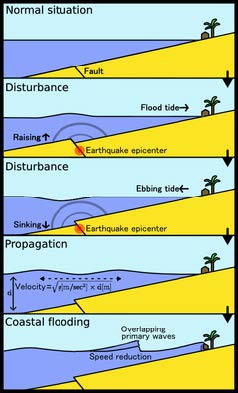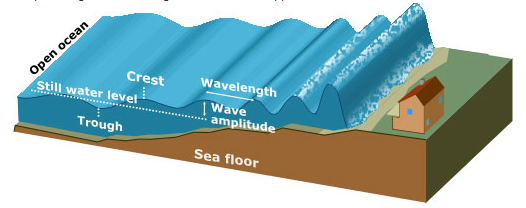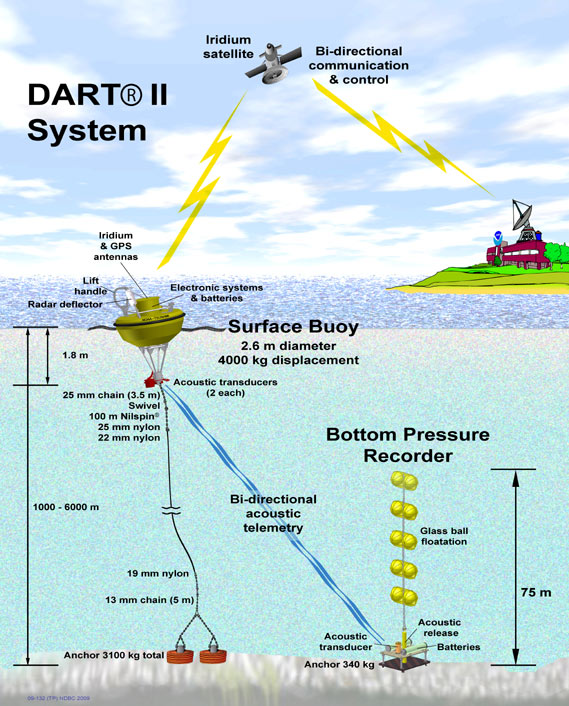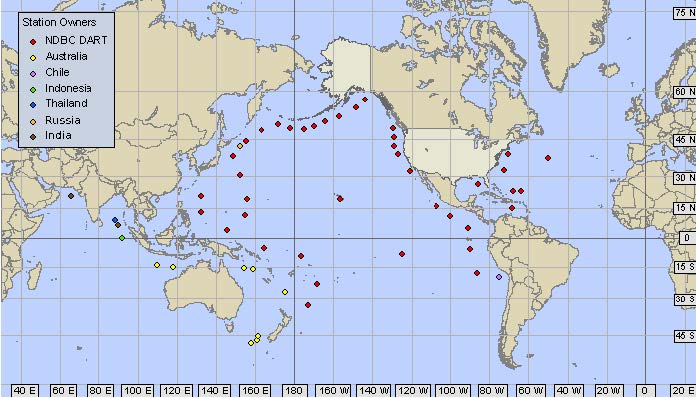Table of Contents
Tsunami
Authors: Kilian Aregger (2015), Yuan Jin (2014)
Definition
A tsunami (Japanese word for “harbour wave”) is a series of waves in a ocean or a large lake caused by the displacement of a large volume of water. Reasons for such a displacements are earthquakes, volcanic eruptions and other underwater explosions, landslides, glacier calvings, meteorite impacts. In contrast to wind-driven sea waves, tsunami waves have a far longer wavelength. On the open ocean the waves are hardly viewable due to their small wave height but their distance from one wave crest to the next wave crest can be between 100 and 300km. When these waves reach the coast, they create a rapidly rising tide. That's why tsunamis are also called tidal waves. The waves of a tsunami arrive the coast within periods ranging from minutes to hours and have possible heights of tens of meters. A tsunami impacts only coastal areas but with an enormous destructive power. [1]
Formation process
For the formation of a tsunami there must occur a disturbance with high intensity (e.g. an earthquake with at least 7,0 on the Richter scale), so that there is enough energy released to rapidly displace enough water. Furthermore this displacement must occur vertical. A horizontal displacement won't create a tsunami. The resulting waves due to the displacement spread over the open sea with the velocity as high as thousand kilometers per hour and approach the surrounding coasts rapidly. In shallower water the wave will slow down but towers into a wave wall as much as 30 meters high. The reason for this is the mass of water and energy contained in the tsunami wave. Whereas only the upper water layers are being moved in wind created waves, with a tsunami wave, an entire mass of water from the sea bed to the surface is in motion. [2]
SlwZzbGh7Cw
Wave characteristics
Long period
Compared with wind-generated waves in the ocean, which are commonly observed near the beach and have the period of five to twenty seconds, tsunami has much longer period, ranging between 10 minutes to 2 hours [4].
Shallow-water waves
Tsunami belongs to shallow-water wave, which is characterized by long wavelength relative to shallow water depth (the ratio between water depth d and wavelength L is below 0.05). The wavelength of longest wind-generated waves is usually shorter than 200m. In contrast, the wavelength of tsunami can be as high as 50km [4].
Wave velocity decreases as tsunami approaches coastal areas.
There is an important property of shallow-water waves with regard to the wave velocity. Equation (1) below is the general equation of wave speed [8]. L and d stand for wavelength and water depth, respectively. \begin{equation*} c = \sqrt{\frac{gL}{2\pi} \tanh{\frac{2\pi d}{L}}} \end{equation*} In shallow-water bodies, i.e. the ratio d/L is smaller than 0.05, equation (1) can be approximated to equation (2): \begin{equation*} c = \sqrt{gd} \end{equation*} This indicates that the wave speed of tsunami is proportional to the acceleration of gravity and water depth. And this is why tsunami travels with very high speed in the open ocean where the depth is large, while slows down once it approaches the shallow coastal areas. Additionally, as the rate of energy loss is inversely proportional to wavelength, tsunami waves are less susceptible to energy loss while travelling over long distances. And this makes tsunami very destructive.
Small amplitude in the open sea, but large amplitude offshore.
Tsunami has small amplitude in the open ocean; nevertheless, as it approaches the coast, the height increases sharply and sometimes bore can be created. Bore means that the waves have steep front, just like water wall. The bore can be as high as 15m. The figure below illustrates this phenomenon [3].
The wave speed is inversely proportional to the square of wave height, which is manifested from equation (3) (See chapter 1.5 Waves approaching the shore for detailed derivation.): \begin{equation*} \frac{c1}{c2} = \frac{H2^2}{H1^2} \end{equation*} According to this relationship, as tsunami approaching the coast has a decreases in the wave speed, the wave height or amplitude will increases.
Implications, historical background
According to the second and third characteristics, tsunami waves travel with fast velocity but small amplitude in the open ocean, which makes tsunami very difficult to be predicted. However, once the waves reach the coast, the velocity slows down and the amplitude increases sharply, generating extremely destructive power. Tsunami not only causes serious damage to the public properties, but also poses threats to people’s lives. One of the most serious natural disasters recorded in history is 2004 Indian Ocean tsunami[4]. It is caused by Sumatra-Andaman earthquake, which has the magnitude between 9.1 and 9.3 and is the third largest earthquake ever observed in history. The wave height generated by the earthquake is as high as 30 meters, and 230000 people were killed in this disaster. [7]
To save lives and reduce the damage of tsunamis to the maximum extent, early alarming systems are required. Therefore National Oceanic and Atmospheric Administration (NOAA) has placed Deep-ocean Assessment and Reporting of Tsunami (DART) stations at sites in regions with a history of generating destructive tsunamis. The DART systems consist of an anchored seafloor bottom pressure recorder (BPR) and a companion moored surface buoy for real-time communications. The BPR measures temperature and pressure at 15-second intervals. [5]
Furthermore there are communication facilities to warn people of the occurrence of tsunamis. Till now, there are four international warning systems, including Pacific Ocean (PTWC), Indian Ocean (IOTWS), North Eastern Atlantic, the Mediterranean and Connected Seas (NEAMTWS) and Caribbean[6].
References
- [1] Tsunami.http://en.wikipedia.org/wiki/Tsunami (Enquiry date: 21 May 2015)
- [2] The formation of a Tsunami.http://www.tsunami-alarm-system.com/en/phenomenon-tsunami/phenomenon-tsunami-formation.html (Enquiry date: 21 May 2015)
- [3] Open University,Chapter 1.5: Waves, Tides and Shallow-Water Process
- [4] Physics of Tsunamis.http://wcatwc.arh.noaa.gov/?page=tsunami_science (Enquiry date: 21 May 2015)
- [5] Deep-ocean Assessment and Reporting of Tsunamis (DART®) Description.http://www.ndbc.noaa.gov/dart/dart.shtml (Enquiry date: 21 May 2015)
- [6] Tsunami warning system.http://en.wikipedia.org/wiki/Tsunami_warning_system (Enquiry date: 21 May 2015)
- [7] 2004 Indian Ocean earthquake and tsunami.http://en.wikipedia.org/wiki/2004_Indian_Ocean_earthquake_and_tsunami (Enquiry date: 21 May 2015)
- [8] How tsunami develop.http://www.waikatoregion.govt.nz/Services/Regional-services/Regional-hazards-and-emergency-management/Coastal-hazards/Tsunami/ (Enquiry date: 21 May 2015)
Comments
Todo
- Please give example values of the wave velocity in m/s and km/h; e.g. the phase speed in the deep ocean (Depth = 4000m) and in coastal areas (Depth = 100m).
- Add cross-links to other wiki-articles on waves inside the article where appropriate.
— Samuel Eberenz 2015/05/26 09:46



